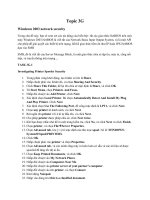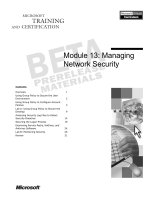Network Security
Bạn đang xem bản rút gọn của tài liệu. Xem và tải ngay bản đầy đủ của tài liệu tại đây (672.58 KB, 86 trang )
8: Network Security
8-1
Chapter 8
Network Security
A note on the use of these ppt slides:
We’re making these slides freely available to all (faculty, students, readers).
They’re in PowerPoint form so you can add, modify, and delete slides
(including this one) and slide content to suit your needs. They obviously
represent a lot of work on our part. In return for use, we only ask the following:
If you use these slides (e.g., in a class) in substantially unaltered form, that
you mention their source (after all, we’d like people to use our book!)
If you post any slides in substantially unaltered form on a www site, that
you note that they are adapted from (or perhaps identical to) our slides, and
note our copyright of this material.
Thanks and enjoy! JFK/KWR
All material copyright 1996-2006
J.F Kurose and K.W. Ross, All Rights Reserved
Computer Networking:
A Top Down Approach
Featuring the Internet
,
3
rd
edition.
Jim Kurose, Keith Ross
Addison-Wesley, July
2004.
8: Network Security
8-2
Chapter 8: Network Security
Chapter goals:
❒
understand principles of network security:
❍
cryptography and its
many
uses beyond
“confidentiality”
❍
authentication
❍
message integrity
❍
key distribution
❒
security in practice:
❍
firewalls
❍
security in application, transport, network, link
layers
8: Network Security
8-3
Chapter 8 roadmap
8.1 What is network security?
8.2 Principles of cryptography
8.3 Authentication
8.4 Integrity
8.5 Key Distribution and certification
8.6 Access control: firewalls
8.7 Attacks and counter measures
8.8 Security in many layers
8: Network Security
8-4
What is network security?
Confidentiality: only sender, intended receiver
should “understand” message contents
❍
sender encrypts message
❍
receiver decrypts message
Authentication: sender, receiver want to confirm
identity of each other
Message Integrity: sender, receiver want to ensure
message not altered (in transit, or afterwards)
without detection
Access and Availability: services must be accessible
and available to users
8: Network Security
8-5
Friends and enemies: Alice, Bob, Trudy
❒
well-known in network security world
❒
Bob, Alice (lovers!) want to communicate “securely”
❒
Trudy (intruder) may intercept, delete, add messages
secure
sender
secure
receiver
channel
data, control
messages
data
data
Alice
Bob
Trudy
8: Network Security
8-6
Who might Bob, Alice be?
❒
… well,
real-life
Bobs and Alices!
❒
Web browser/server for electronic
transactions (e.g., on-line purchases)
❒
on-line banking client/server
❒
DNS servers
❒
routers exchanging routing table updates
❒
other examples?
8: Network Security
8-7
There are bad guys (and girls) out there!
Q: What can a “bad guy” do?
A: a lot!
❍
eavesdrop:
intercept messages
❍
actively
insert
messages into connection
❍
impersonation:
can fake (spoof) source address
in packet (or any field in packet)
❍
hijacking:
“take over” ongoing connection by
removing sender or receiver, inserting himself
in place
❍
denial of service
: prevent service from being
used by others (e.g., by overloading resources)
more on this later ……
8: Network Security
8-8
Chapter 8 roadmap
8.1 What is network security?
8.2 Principles of cryptography
8.3 Authentication
8.4 Integrity
8.5 Key Distribution and certification
8.6 Access control: firewalls
8.7 Attacks and counter measures
8.8 Security in many layers
8: Network Security
8-9
The language of cryptography
symmetric key crypto: sender, receiver keys
identical
public-key crypto: encryption key
public
, decryption key
secret (
private)
plaintext
plaintext
ciphertext
K
A
encryption
algorithm
decryption
algorithm
Alice’s
encryption
key
Bob’s
decryption
key
K
B
8: Network Security
8-10
Symmetric key cryptography
substitution cipher: substituting one thing for another
❍
monoalphabetic cipher: substitute one letter for another
plaintext: abcdefghijklmnopqrstuvwxyz
ciphertext: mnbvcxzasdfghjklpoiuytrewq
Plaintext: bob. i love you. alice
ciphertext: nkn. s gktc wky. mgsbc
E.g.:
Q: How hard to break this simple cipher?:
brute force (how hard?)
other?
8: Network Security
8-11
Symmetric key cryptography
symmetric key crypto: Bob and Alice share know same
(symmetric) key: K
❒
e.g., key is knowing substitution pattern in mono
alphabetic substitution cipher
❒
Q: how do Bob and Alice agree on key value?
plaintext
ciphertext
K
A-B
encryption
algorithm
decryption
algorithm
A-B
K
A-B
plaintext
message, m
K (m)
A-B
K (m)
A-B
m = K ( )
A-B
8: Network Security
8-12
Symmetric key crypto: DES
DES: Data Encryption Standard
❒
US encryption standard [NIST 1993]
❒
56-bit symmetric key, 64-bit plaintext input
❒
How secure is DES?
❍
DES Challenge: 56-bit-key-encrypted phrase
(“Strong cryptography makes the world a safer
place”) decrypted (brute force) in 4 months
❍
no known “backdoor” decryption approach
❒
making DES more secure:
❍
use three keys sequentially (3-DES) on each datum
❍
use cipher-block chaining
8: Network Security
8-13
Symmetric key
crypto: DES
initial permutation
16 identical “rounds” of
function application,
each using different
48 bits of key
final permutation
DES operation
8: Network Security
8-14
AES: Advanced Encryption Standard
❒
new (Nov. 2001) symmetric-key NIST
standard, replacing DES
❒
processes data in 128 bit blocks
❒
128, 192, or 256 bit keys
❒
brute force decryption (try each key)
taking 1 sec on DES, takes 149 trillion
years for AES
8: Network Security
8-15
Public Key Cryptography
symmetric
key crypto
❒
requires sender,
receiver know shared
secret key
❒
Q: how to agree on key
in first place
(particularly if never
“met”)?
public
key cryptography
❒
radically different
approach [Diffie-
Hellman76, RSA78]
❒
sender, receiver do
not
share secret key
❒
public
encryption key
known to
all
❒
private
decryption
key known only to
receiver
8: Network Security
8-16
Public key cryptography
plaintext
message, m
ciphertext
encryption
algorithm
decryption
algorithm
Bob’s public
key
plaintext
message
K (m)
B
+
K
B
+
Bob’s private
key
K
B
-
m = K (K (m))
B
+
B
-
8: Network Security
8-17
Public key encryption algorithms
need K ( ) and K ( ) such that
B
B
.
.
given public key K , it should be
impossible to compute private
key K
B
B
Requirements:
1
2
RSA: Rivest, Shamir, Adelson algorithm
+
-
K (K (m)) = m
B
B
-
+
+
-
8: Network Security
8-18
RSA: Choosing keys
1. Choose two large prime numbers
p, q.
(e.g., 1024 bits each)
2. Compute
n = pq, z = (p-1)(q-1
)
3. Choose
e (
with
e<n)
that has no common factors
with z. (
e, z
are “relatively prime”).
4. Choose
d
such that
ed-1
is exactly divisible by
z
.
(in other words:
ed
mod
z = 1
).
5.
Public
key is
(n,e).
Private
key is
(n,d).
K
B
+
K
B
-
8: Network Security
8-19
RSA: Encryption, decryption
0. Given (
n,e
) and (
n,d
) as computed above
1. To encrypt bit pattern,
m
, compute
c = m
mod
n
e
(i.e., remainder when
m
is divided by
n
)
e
2. To decrypt received bit pattern,
c
, compute
m = c
mod
n
d
(i.e., remainder when
c
is divided by
n
)
d
m = (m
mod
n)
e
mod
n
d
Magic
happens!
c
8: Network Security
8-20
RSA example:
Bob chooses
p=5, q=7
. Then
n=35, z=24
.
e=5
(so
e, z
relatively prime).
d=29
(so
ed-1
exactly divisible by z.
letter
m
m
e
c = m mod n
e
l
12
1524832
17
c
m = c mod n
d
17
481968572106750915091411825223071697
12
c
d
letter
l
encrypt:
decrypt:
8: Network Security
8-21
RSA: Why is that
m = (m
mod
n)
e
mod
n
d
(m
mod
n)
e
mod
n = m
mod
n
d
ed
Useful number theory result: If
p,q
prime and
n = pq,
then:
x
mod
n = x
mod
n
y y
mod
(p-1)(q-1)
= m
mod
n
ed
mod
(p-1)(q-1)
= m
mod
n
1
= m
(using number theory result above)
(since we chose
ed
to be divisible by
(p-1)(q-1)
with remainder 1 )
8: Network Security
8-22
RSA: another important property
The following property will be
very
useful later:
K (K (m)) = m
B
B
-
+
K (K (m))
B
B
+
-
=
use public key
first, followed
by private key
use private key
first, followed
by public key
Result is the same!
8: Network Security
8-23
Chapter 8 roadmap
8.1 What is network security?
8.2 Principles of cryptography
8.3 Authentication
8.4 Integrity
8.5 Key Distribution and certification
8.6 Access control: firewalls
8.7 Attacks and counter measures
8.8 Security in many layers
8: Network Security
8-24
Authentication
Goal: Bob wants Alice to “prove” her identity
to him
Protocol ap1.0: Alice says “I am Alice”
Failure scenario??
“I am Alice”
8: Network Security
8-25
Authentication
Goal: Bob wants Alice to “prove” her identity
to him
Protocol ap1.0: Alice says “I am Alice”
in a network,
Bob can not “see”
Alice, so Trudy simply
declares
herself to be Alice
“I am Alice”









